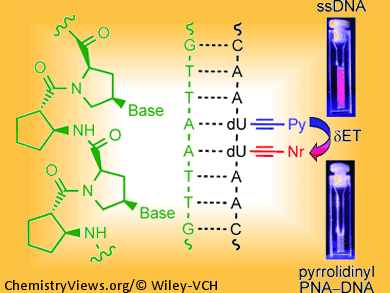Peptide nucleic acids (PNA) are artifically synthesized polymers similar to DNA or RNA. Such nucleic acids are of interest as supramolecular scaffolds for the precise arrangement of chromophores in new multifluorescent probes for bioanalytics and for new multiluminescent organic materials. The potential to control chromophore interactions comes from the geometry of the double helical structure on the nucleic acids.
Tirayut Vilaivan, Chulalongkorn University, Thailand, Hans-Achim Wagenknecht, Karlsruhe Institute of Technology (KIT), Germany, and co-workers studied modifications of their white-light emitting DNA (WED) probes that combine ethynyl pyrene and ethynyl nile red as blue-green and red emitters, respectively. By using pyrrolidinyl PNA as the counterstrand to conformationally restrict the nucleic acid geometry, they achieve improved photophysical properties of their fluorescent probe. Due to properties such as the formation of more stable hybrids with DNA compared to RNA and lack of self-pairing hybrids, sterically constrained (2S)-aminocyclopentane-(1S)-carboxylic acid (acpc) PNA was especially interesting as a counterstrand.
They found higher melting temperatures of their probes, pronounced sequence selectivity including mismatch discrimination and almost equal contributions of ethynyl pyrene and ethynyl nile red emissions, adding to the properties of the WEDs.
 Conformational Control of Dual Emission by Pyrrolidinyl PNA–DNA Hybrids,
Conformational Control of Dual Emission by Pyrrolidinyl PNA–DNA Hybrids,
Sabrina Sezi, Reji Varghese, Tirayut Vilaivan, Hans-Achim Wagenknecht,
ChemistryOpen 2012, 1(4), 173–176.
DOI: 10.1002/open.201200016
ChemistryOpen – the first society-owned, open-access, chemistry journal – is a journal of ChemPubSoc Europe published by Wiley-VCH.


